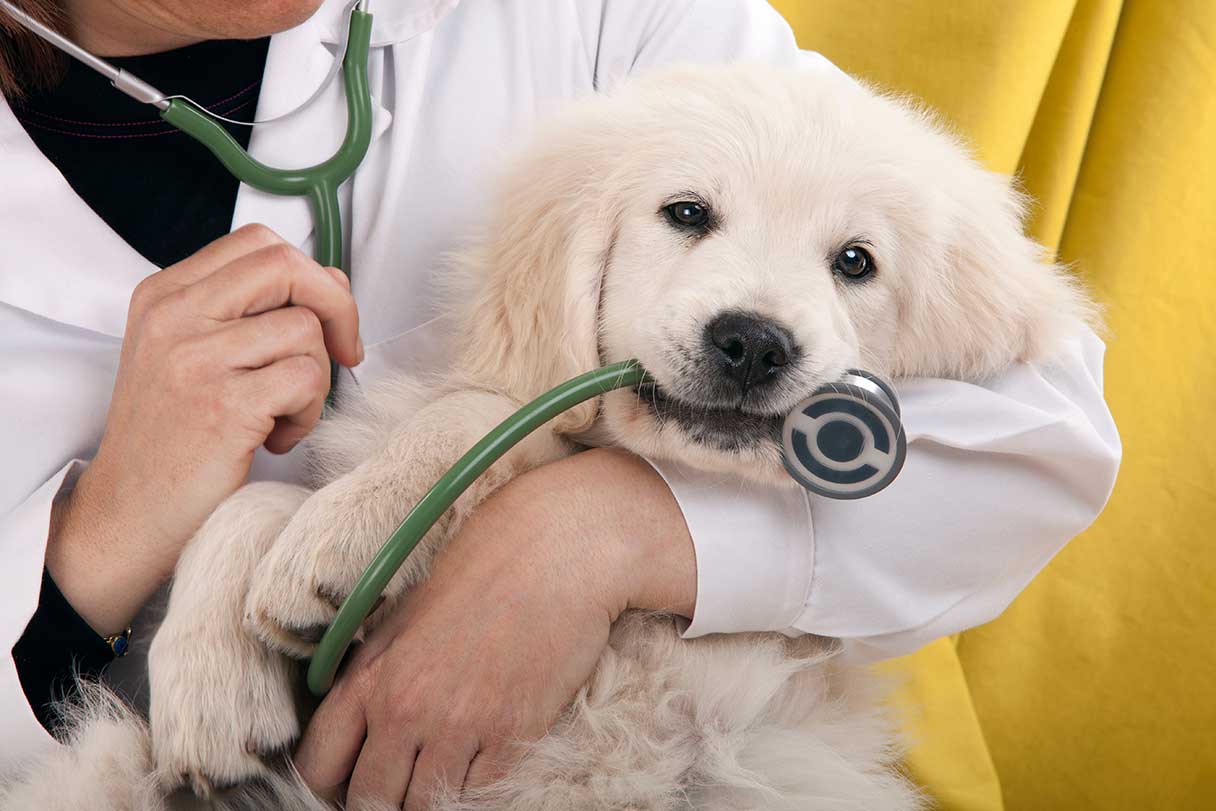Whether they're short, long, up, down, smooth or fluffy, dog ears are adorable. With their amazing hearing abilities and tendency to become infected, they're also a bit mystifying. How well do they hear, exactly? What else are the ears used for? And what is it about dog ears that makes them so susceptible to infections? Those are just a few of the questions answered below.
Keep reading to learn 29 things about your dog's ears and how to keep them healthy.
Read Related Articles
11 Common Dog Behavior Issues and Tips To Fix Them
13 Fun Facts About Your Dog's Sense of Smell
1. Dogs Communicate With Their Ears
Dogs communicate primarily through body language, and a big part of that language is “spoken" with their ears. Along with other body cues, the position of your pup's ears can help convey whether they're happy, excited, alert and interested — or stressed.1
2. Dog Ears Have Lots of Muscles
A dog's ears contain more than 18 muscles, compared to only six in human ears. These allow dogs to raise and lower their ears to convey emotions, and also swivel them to zoom in on sounds.2
3. Dogs Can Move Their Ears Independently
You might think it's a neat trick when humans can wiggle their ears. But all those dog ear muscles not only give their ears far more mobility, they also make it possible for each ear to move independently of one another.1 This is why each of your dog's ears can be pointed in opposite directions, or one can be raised while the other flops over.
4. Dogs Hear Four Times Better Than Humans
What you can hear from 20 feet away, your dog can hear from 80 feet away. They also hear a much wider range of frequencies, including ultrasonic frequencies that are too high to be accessed by the human ear.2
5. But They Don't Hear as Well as Cats
Dogs have super hearing at higher frequencies compared to humans, who on average hear within a range of 20 to 20,000 hertz (Hz).3 Dog ears can pick up a range of 67 to 45,000 Hz.4 But cats have them beat with a hearing range of 45 to 85,000 Hz.4 In fact, cats have one of the broadest hearing range of all land mammals.4
6. Hearing Higher Frequencies Helps Dogs Be Better Hunters
Once upon a time, before domestication and breeding divvied up dogs into specialized groups and functions, all dogs were hunters. Even now, the ability to hear sounds on a higher frequency spectrum helps dogs detect the presence of rodents and other critters.2
7. Dog Ears Are Sensitive to Touch
A dog's ears are full of nerve endings, which make them one of the most sensitive parts of their body, along with their bellies and the skin between their toes. The vagus nerve, which helps control the central nervous system, is also located in the ears of dogs. This might explain why dogs find it so relaxing when you rub their ears.2
8. The Longest Dog Ears on Record Were Over a Foot Long
It might not be a surprise that the record holder for the world's longest dog ears ever was a bloodhound named Tigger, who won the crown in 2004 with a right and left ear that measured 13.75 inches and 13.5 inches, respectively.5 But a coonhound named Lou broke the record for the longest ears on a currently living dog in 2021, with ears that measured 13.38 inches each.6
9. Hounds' Long Ears Help Them Smell
Scent hounds all tend to have extra-long ears, along with a higher olfactory capacity than most other dogs. Those ears drag along the ground and collect scents around the nose, amplifying the smells and making it easier for hounds to track by scent.2
10. Dogs Can Recognize Some Words
Dogs are capable of recognizing and understanding the meaning of a variety of words — and not just the ones you deliberately teach them, like their name or obedience commands. Dogs can also passively pick up on the meaning of words that are significant to them, like “walk" or “treat." Their ears also become highly attuned to certain sounds, like the crackle of a bag of food when you open it.7
11. But They Have a Hard Time Distinguishing Similar Words
As astute as dogs can be at learning words, they also have a hard time hearing or understanding the difference between similar-sounding words. They lack the language processing capabilities to understand nuances of language the same way humans do.2
12. Dogs Can Pick Out Their Names in Noisy Rooms
With their excellent hearing, dogs hear a lot more sounds than we do. But your super pup also has the ability to filter out extraneous noise and hone in on sounds that are important to them.1 This includes their name2 and the sound of your voice.1
13. That Doggie Head Tilt Helps Them Focus on Certain Words or Sounds
Your dog's ability to filter out extraneous noise includes all those words you say that they don't understand. When they finally hear a word or a sound that has meaning to them, you'll know by the way they perk up their ears and tilt their head. They do this to listen more intently — no doubt hoping you'll say more of what they want to hear.2
14. Puppies Are Born Without Hearing
Dogs aren't born with super hearing. At birth, their ear canals, like their eyes, are sealed up, leaving them essentially deaf.1 This protects their sensitive ears from injury due to loud noises.2 Their ears open up around 3 weeks of age, and their hearing continues to develop until they're about 2 months old.1
15. They Can Lose Their Hearing as They Age
Dogs don't always keep their excellent hearing. Like humans, aging dogs are sometimes prone to hearing loss. They can also lose their hearing due to illness or injury. If your dog stops responding to their name or tilting their head when you say their favorite words, those may be signs that you should see your vet for a hearing check.8
16. Some Dog Breeds Are Prone to Deafness
Certain dog breeds are predisposed to congenital deafness — they're not just born with closed ears but with ears that never gain the ability to hear. These include:9
- Australian cattle dogs
- Australian shepherds
- Boston terriers
- Bull terriers
- Catahoula leopard dogs
- Dalmatians
- English cocker spaniels
- English setters
- Russell terriers
17. Deafness in Dogs Is Related to Pigmentation
Hereditary deafness in dogs is associated with two genes that control pigmentation in dogs. Dogs with the merle coat pattern gene and the piebald coat gene have a higher tendency to be born with ears that never gain hearing function. This is thought to be due to lack of sufficient blood flow to the cochlea.2
18. Dogs Can Use Hearing Aids and Ear Protection
You can get dog hearing aids to help aging dogs who are losing their hearing.10 Also, if you take your dog to places with loud noises, like construction sites or rock concerts, you can protect their hearing and help prevent ear damage with protective earmuffs made especially to fit dogs.11
19. Dog Ears Emit Pheromones
Have you ever wondered why dogs like to sniff one another's ears when they meet each other? It's because their ears contain glands that release pheromones. Not only do these pheromones tell dogs a lot about each other, but they're also similar to the pheromones released by a mother dog to help her puppies recognize her.1
20. Dog Ears Can Swell Like a Balloon
The ear flap on a dog can develop an aural hematoma: a pocket that fills with blood and swells into the shape of an inflated balloon. This can be caused when your dog shakes their head too hard or scratches their ear flaps too much, causing blood vessels to break beneath the skin.2 They're usually treated by either steroidal medication or surgery.12
21. Dog Ears Sometimes Smell Like Corn Chips
The inside of a dog's ear is a perfect environment for yeast and bacteria. That yeasty growth has a smell that's very similar to your favorite corn chips or taco shells. The waste byproducts produced by the bacteria also contribute to the corn-like smell. While you might enjoy the smell, it's a sign that you need to clean your dog's ears. If left unchecked, that yeast and bacteria could grow into an ear infection.13
22. Dog Ear Canals Are L-Shaped
The L-shape of a dog's ear canal prevents all that yeast and bacteria, along with dirt and debris, from getting into the inner ear. But the drawback is that if they're not kept clean, all the gunk that gets trapped in the ear canal can lead to infections and other ear problems.1
23. Part of Your Dog's Ear Is Called a Henry's Pocket
That little skin flap that forms a sort of pocket on the outer edge of your dog's ear actually has a name: Henry's pocket. Its exact purpose is unknown, but there are a few theories. One is that it serves to amplify sounds. Another is that it acts as a sort of hinge that lets dogs flatten their ears.1
24. Dog Ears Come in Different Shapes and Sizes
Just as dogs themselves come in a wide and diverse range of shapes and sizes, so do their ears.1 In fact, there are no fewer than 12 different identified dog-ear shapes.14 Long and floppy, short and erect, large or small, the size and shape of a dog's ears is usually the result of breeding and genetics.14
25. Each Ear Shape Has Its Own Name
In describing different dog breeds and the breed standards for their appearance, dog breeders and enthusiasts have come up with names for each type of dog ear:14
| Ear shape | Example dog breed |
|---|---|
|
Erect |
German shepherd |
|
Drop |
Golden retriever |
|
Blunt |
French bulldog |
|
Bat |
Chihuahua |
|
Rose |
Whippet |
|
Hooded |
Basenji |
|
Semi-pricked |
Collie |
|
Candle flame |
English toy terrier |
|
Button |
Pug |
|
Folded |
Bloodhound |
|
Butterfly |
Papillon |
|
Filbert |
Bedlington terrier |
26. Dog Ear Plucking Is a Thing
Ear hair doesn't just plague old men. Some dog breeds, like poodles, bichons and shih tzus, have so much hair growing inside their ears that it reaches into the ear canal. Plucking this excess ear hair helps increase airflow into the ear, reducing moisture and the likelihood of infections.2 Talk to your vet about the best course of action if you have concerns about your dog's excess ear hair.
27. Ear Infections Are the Most Common Dog Ailment
Dogs can experience a lot of health problems, but ear infections are the most common. They're also the number one reason for vet visits.1 Signs of ear infections in dogs include:15
- Head shaking
- Ear scratching
- Ear odor
- Ear discharge
- Swelling and redness
- Scabs or crusting
If you notice any of these signs, you should have your dog's ears examined by a vet.
28. Floppy Dog Ears Are More Prone to Infections
Ear infections can strike all dogs. But dogs with long and floppy or droopy ears tend to be more prone to developing ear infections. Dog breeds that are especially prone to ear infections include:1
- Cocker spaniels
- Miniature poodles
- Old English sheepdogs
- Basset hounds
29. Dog Ear Infections Are Easily Preventable
Ear infections are uncomfortable and painful for your dog. Thankfully, preventing them is a relatively simple matter of inspecting your dog's ears on a regular basis and keeping them clean and dry. You can clean your pup's ears with an ear rinse or ear wipes made for dogs, and be sure to dry them good after bathing or swimming.8 If needed, your vet can also provide you with an ear powder to help their ears stay dry.15
Maintaining Good Dog Ear Health
Dog ears are complex organs that need a certain amount of maintenance and care to stay healthy. But now that you know so much about your dog's ears, you can understand not only how to take care of them but also why it's important and why signs of infection should always be checked out by your vet.
CareCredit Credit Card Financing for Dog Care
Taking good care of your pet's well-being from nose to tail is essential. Make sure to stay up to date on their regular checkups at the vet to help keep your pet happy and healthy for a lifetime of love. You can use your CareCredit credit card for pet care throughout the year for routine veterinary services as well as emergencies and surgeries.* Use our Acceptance Locator to find a veterinarian near you that accepts CareCredit.
CareCredit is there for you and your pet every step of the way; continue your wellness journey by downloading the CareCredit Mobile App to manage your account, find a provider on the go and easily access the Well U hub for more great articles, podcasts and videos.
In addition to pet care, you can also use your CareCredit credit card for dentistry, cosmetic, vision, hearing, health systems, dermatology, pharmacy purchases, spa treatments and so much more within the CareCredit network. How will you invest in your health and wellness next?
Author Bio
Jean Marie Bauhaus is a freelance writer and novelist who has been writing pet content since 2013. Her work has appeared on Forbes.com, Hill's Pet, Chewy, AKC.org and more.







